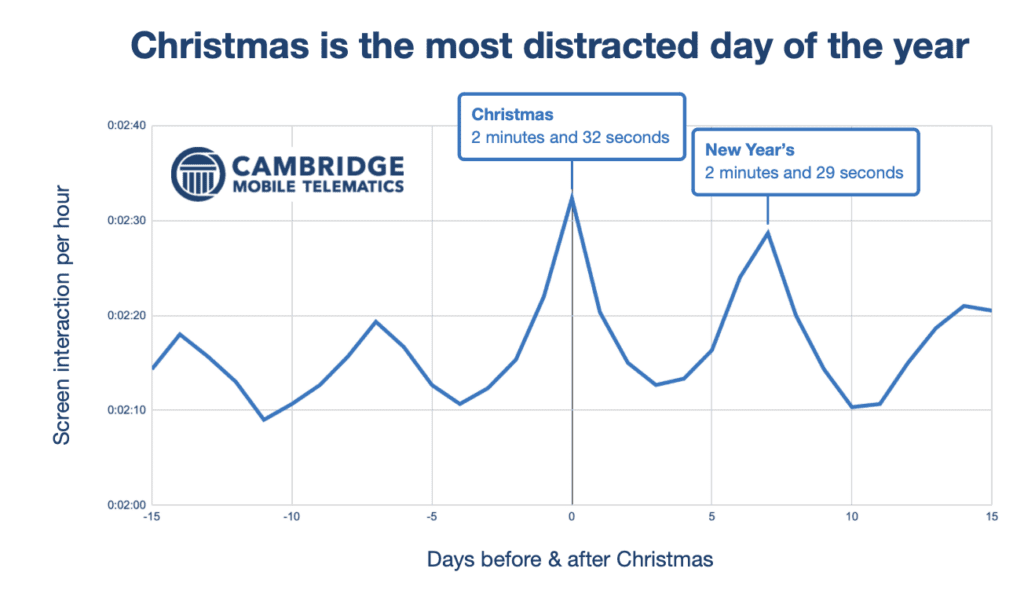Christmas and New Year’s day are a time of joy and celebration, but the holidays also bring heightened risks on the highway.
According to a new analysis of traffic patterns and driver behavior, Christmas and New Year’s day are the most distracted driving days of the year. Christmas also is the day when drivers are more likely to speed than any other, while New Year’s day comes in fourth.

While driver cell phone use – either talking or texting, or simply surfing the internet – is an everyday risk factor on the highway, these distracted driving practices consistently spike during the holidays.
And that, sadly, means more car crashes.
In a report titled “Road Risk Alert: It’s the most Distracted Time of the Year” Cambridge Mobile Telematics concluded that the increase in distracted driving during the holidays caused 2,000 additional crashes, five fatalities and $47 million in damages during the three years surveyed by company data scientists.
On a typical day during the Christmas season, drivers spent an average of 2 minutes and 16 seconds per hour on their cell phones. But on Christmas day itself, the time spent on cell phones jumped to 2 minutes and 32 seconds, an 11 percent increase.

“CMT’s analysis reinforces the need for all drivers to stay focused, put the phone down and check their speed to ensure they arrive safely,” the company said in a statement released with the study.
CMT, a riving data and analysis firm that develops information on distracted driving trends for insurance companies, and state and local governments, defines distracted driving as phone movement or screen activation while a car is moving more than 9 miles per hour. The company, founded by MIT data scientists in 2010, has produced a treasure trove information on driver behavior that is now guiding state and local government policy makers as well as insurers seeking to better refine their rate structures and encourage safer driving practices.
The company traces its origins to a project initiated in 2004 by two MIT data scientists, Hari Balakrishna and Sam Madden, dubbed the CarTel project, using mobile sensing system to collect and develop data from mobile devices. The following year they partnered with a Boston taxi company to use their new technology to accurately measure road surface conditions. Their work won academic acclaim and in 2010 they joined with Bill Powers to found Cambridge Mobil Telematics.
The company, which measures and analyzes data from 10 million drivers every day, uses smart phones and auto tags that communicate directly with insurers among other devices to collect and sift through data that can show in real time when a driver is distracted. Cell phone use is detected by CMT sensors when the phone is physically moved or when the phone screen is activated.
Before the advent of real time data collection, policy makers and insurers could only draw inferences after an accident occurred. As a consequence, relatively little was known about distracted driver behavior, and much of that was anecdotal and imprecise.
“The extent of distracted driving has been vastly underestimated for years. Cambridge Mobile Telematics is addressing this inadequacy and their data is shedding light on the prevalence of distracted driving,” said Joel Feldman, who along with his wife, Dianne Anderson, founded EndDD.org to raise public awareness about the dangers of distracted driving.
“But beyond just providing accurate data, their innovative provision of feedback to drivers through most insurance company safe driving apps is making the roads safer for all of us and helping to reduce insurance costs,” Feldman added.
CMT data on distracted driving is revealing.
More than a third of auto crashes involved cell phone use. The company says that in 34 percent of crashes the driver was holding a cell phone at least one minute before the crash. The most distracted drivers – those who are using their cell phones while driving – are 2.2 times more likely to crash. A 10 percent decrease in distracted driving would save 1,300 lives a year.
Overall, the trend lines in distracted driving are dispiriting, a look at company data would suggest. From 2020 to 2022 distracted driving, defined by cell phone movement or screen activation, increased by 20 percent.
It appears that there is a tight correlation between cell phone use and highway risk.
When the iPhone was introduced in 2007 there was a total of 4,600 pedestrians killed on American roadways. By 2021, 85 percent of adult Americans were using cell phones, and the number of pedestrians killed on U.S highways had jumped to 7,485, the most in 40 years, the company said. In addition, there were 985 bicycle fatalities, the highest number since 1990.
The National Highway Traffic Safety Administration estimates that 3,522 pedestrians were killed as a result of distracted driving in 2021 but cautioned that number likely underestimates the carnage.
One bright spot is that policy makers and insurers are enacting policies based on distracted driving data aimed at encouraging drivers to adopt safer practices.
Matt Fiorentino, CMT’s president of marketing, said that with the new data on distracted driving, state and local governments can now institute policies and deploy resources in a targeted way to deter distracted driving. And they can tell in real time what is working.
For example, the telematics data collected by CMT can show on which roads and highways distracted driving is more likely to occur, so that they can deploy more traffic cops or signage to deter the practice. Since the data is available instantly, they can quickly evaluate whether a policy is effective.
This has been especially useful with the enactment of hands-free cell phone laws. After Michigan adopted its hands-free law, telematics data showed that distracted driving declined by 13 percent.
Such actionable information has been a great boon to lawmakers fighting for measures to reduce distracted driving, Fiorentino said. When a policy like hands free cell phone laws is enacted those lawmakers can point to hard data showing that the laws save lives.
“We work with states that have distracted driving corridors and they need to make decisions on where to deploy resources,” Fiorentino said.
Before telematics, they made those decisions based in large measure based on anecdotal evidence – after accidents occurred.
“What we are able to do now is give them data (about behaviors) that lead to those crashes,” he said.
Insurers are also making extensive use of telematics generated data by offering discount programs to drivers who enroll. These programs permit insurers to detect driver cell phone use and price their insurance accordingly while providing feedback to drivers, all in an effort to encourage safer driving practices.
“Insurers are able to tell who the safe drivers are, and they are able to incentivize safer behavior,” Fiorentino said. “(Drivers) can save hundreds of dollars a year, so it is a nice cycle.”




